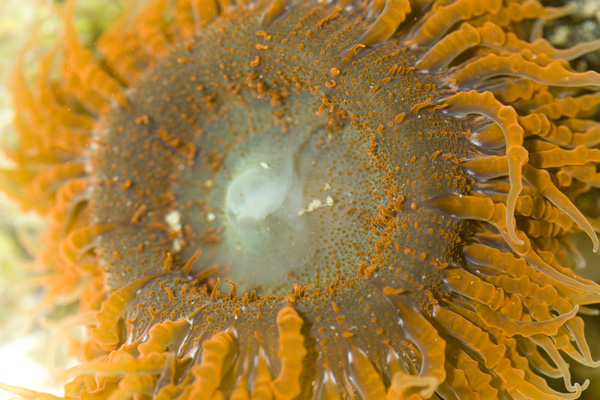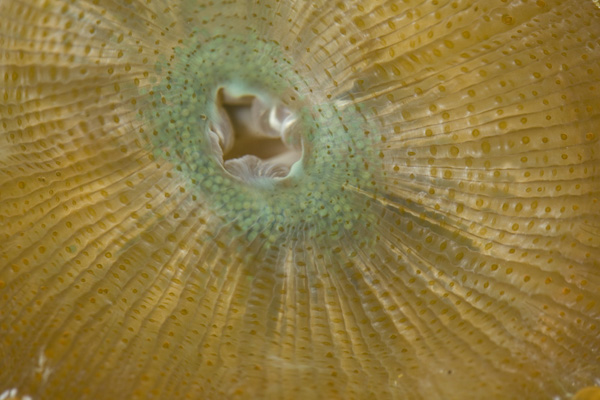‘Anemone Spawn’
A fluorescent green flower anemone (Epicystis crucifer) releases sperm into the water column at the Coral Morphologic lab.
On May 24th we observed this fluorescent green flower anemone (Epicystis crucifer) spawning in our lab, and managed to film the event. The anemone continued to release sperm for nearly 30 minutes, while several other nearby flower anemones released significantly smaller amounts of gametes. This was the second time we have witnessed a flower anemone spawning event at our lab this spring. We first observed a synchronous spawn of more than a dozen anemones in an outdoor aquaculture system that receives natural sunlight on April 12th. After the jump are photos of anemones spawning during this event.
The spawning event in the video took place indoors under artificial lighting in an aquarium set up specifically for their aquaculture. The timing of these two events suggests that the reproductive cycle of the flower anemones are regulated by the cosmic synchronicity of the Earth’s rotation around the Sun (i.e. changing of the seasons), like most coral reef species. It also seems that spawning takes place in the hour or so before sunset. In fact both spawning events that we observed took place between 5-6pm. (under natural and artificial sunlight cycles).
Because corals and anemones cannot generally move themselves to find mates, they have evolved to spawn synchronously, with multiple species all spawning on the same night. The random mixing of its gametes in the water column enables a single coral to spawn with multiple members of its species who are all spawning at the same time all over the reef. It also enables unusual hybridization within and perhaps across genera. In fact, we would suggest that the sexual reproduction of corals directly calls into question the validity of our traditional taxonomic system for categorizing corals into ‘species’.
In 2009 we witnessed several of our flower anemones giving live birth on the Summer solstice (despite being indoors in our lab), but we never witnessed the precursor spawning event. It is clear now that flower anemones are a brooding species that fertilizes its eggs internally. Based on the observation of eggs visible near the mouth of one of the anemones (and the lack of sperm release from it) it appears that flower anemones are likely either male or female. This is noteworthy, because more corals are simultaneous hermaphrodites, possessing both types of sex organs. We now eagerly await to see whether the birthing will occur again on the upcoming summer solstice.
You can read more about the 2009 birthing event and the subsequent baby anemones here.
As far we know, we are the first marine biologists to successfully close the reproductive cycle of this beautiful Caribbean anemone. We look forward to expanding our aquaculture regime of this species to a commercial scale in the coming years. This particular flower anemone can be seen in Lynette Wallworth’s Full-Dome Cinema feature film Coral: Rekindling Venus opening at select planetariums worldwide on June 5th, 2012.



June 3rd, 2012 at 6:12 am
[…] into the aquarium water. This Epicystis crucifer was getting its sexual spawning on in the lab of Coral Morphologic for 30 minutes while several other flower anemones were also observed to be ejecting sperm, […]
June 3rd, 2012 at 1:45 pm
[…] a rare occurrence, Foord and McKay were fortunate enough to catch one of their fluorescent green flower anemone’s…, suddenly filling the tank with its life-giving sperm for almost 30 […]